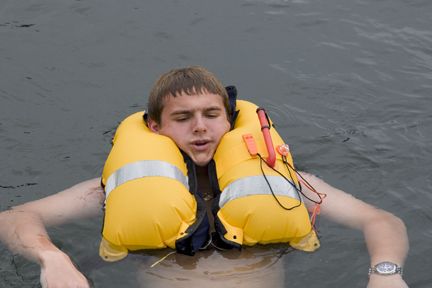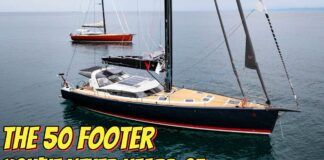Weve received some good suggestions from readers in response to my editorial in the March issue of Practical Sailorthat described our tether and harness design project. Similar to what we did with toddler life jackets back in 2007, the plan is to solicit input from experts in the field, other sailors, and PS readers to try to come up with an improved design for inflatable PFD/harnesses. Because the tether is such an integral part of the PFD/harness when sailing offshore, we plan to work on improved tether designs as well.
While this project has been simmering in the back of my head for a while, it became a high priority in the wake of the WingNuts capsize in last year’s Chicago Yacht Club Chicago to Mackinac Race. We will be reporting on that accident in detail in the April issue, which should be available online soon.
As a first step in this project, weve done some preliminary research in the water. A few weeks ago, Technical Editor Ralph Naranjo and his wife, Lenore, dropped by our office in Sarasota, Fla., and we took some time to re-test a few of the inflatable PFD/harnesses that PS had previously tested. We wanted to see what sort of problems would arise in extreme situations when a person was caught beneath the hull of a boat or dinghy with his PFD inflated.

Granted, the chances of this happening to any sailor are extremely rare, but it has happened before and will no doubt happen again. Our experience with similar, more likely, scenarios such as trying to climb back aboard with a fully inflated PFD, suggested that this capsize scenario was an event worth looking into. Could you escape? If too much buoyancy is a problem, how long would it take to deflate the PFD?
If you visit many of the sailboat racing websites these days, youll see an active discussion regarding auto-inflation versus manual inflation on a PFD/harness. Some sailors disarm the auto-inflation feature because they worry that an accidental auto-inflation caused when the PFD/harness gets wet-either from rain, sea spray, or boarding sea-could put them at risk on deck. This is something to consider. Our own testing has found that some self-inflating PFD/harnesses will inflate when the harness is simply doused with a hose. The most resistant types were the hydrostatic releases, such as those designed by CM Hammar, which are triggered by a pressure change caused by complete immersion.
Anyone who is considering disabling the auto-inflation feature is probably aware of the most obvious consequence-if you are knocked unconscious, your PFD wont inflate. But there are two other consequences that you should be aware of. First, the pull-tab on the manual inflation may not be so easy to grab and pull in an emergency. These are small plastic pull tabs and if you are wearing a lot of clothing or panicked, you might suddenly find yourself treading water, unable to inflate your vest.
Secondly, you should be aware of what is called the gasp reflex. This can occur when a person suddenly hits the water-particularly cold water. Instead of holding his breath, the victim gasps and ingests water, and this reflex that can result in drowning. We have little idea how many of the existing auto-inflate designs would prevent the ingestion of water in a gasp reflex incident. However, an auto-inflate device would still be more likely to save persons life who had experienced this reflex. At least the auto-inflate PFD/harness would give the victim a second chance to recover with his or her head above the water.
Another point worth mentioning: If you typically sail with foul-weather gear and/or insulating layers under your PFD/harness, you should inflate your PFD sometime while you are wearing these clothes as a test. You will likely find the compression around the neck to be startling, enough to incite a brief moment of claustrophobic panic.
Finally, on the topic of tethers. If you have a tether with both short and long legs to attach to the boat, you should not “stow” the loose, unused leg by attaching it to the harness clip-in point. If you have to release yourself from the tether, you are making it doubly hard to get free because you now have not one but two clips to undo. Some people loop the loose leg over their shoulder, or put it on a velcro loop. One solution is to attach the loose leg to a point on the tether itself, but few designs weve seen offer a convenient place for this. This, in our view, is one of the many problems in this type of gear that still needs resolving.
I invite anyone who is interested in contributing expertise or suggestions to our PFD/harness design project to contact me directly at [email protected].





































